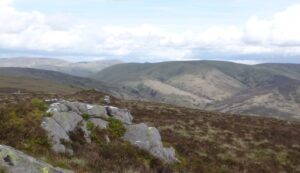Traces of Celtic Culture in the Tarras Valley

Traces of Celtic Culture in the Tarras Valley
The empty expanses of the Tarras valley do not perhaps seem the ideal place to search for traces of human history. When it comes to one particular era however, there are far more than we might expect – and the stories they have to tell are as fascinating as any in the country.
The period in question is that of the Celtic Britons. These were the people whose tribal kingdoms controlled the Southern Uplands between the Bronze Age and the rise of the kingdom of Scotland. Though often seen as former inhabitants, displaced by the Scots and the English, genetics has in fact shown us that the majority of the inhabitants of the Border region today are their descendants.
They left a deep mark on the landscape. Their traces take the form both of physical remains, and the echoes of their lost language too, preserved in place-names. Although a Celtic tongue like Gaelic, their language – called Cumbric – was closer to Welsh and Breton. In the Tarras valley, Cumbric names are unusually common; this was likely one of the last places in which it was spoken.
The word ‘Tarras’ is itself a Cumbric one, meaning either strong or dissolving/thawing river. So too is Cooms, the name of the farm in the heart of the valley and also of the fell to its east; it means small valley or corrie. The word ‘rwn’ – pronounced ‘roon’ – is a form of the Welsh word for ridge; it is likely from a related Cumbric term that Roan Fell takes its name. ‘Allery’ in Allery Sike derives either from a word for flowing, or shining/sparkling; ‘Perter’ in Perterburn farm means stream of the thicket/bush; and the ‘Cronk’ in nearby Cronksbank farm derives from ‘cruc’, meaning hillock or burial mound.
Perhaps most intriguingly, the pass at the head of the valley, Ludsgill Sware, may connect to a legendary king of Britain named Ludd. This figure appears in Welsh legend, and derives from pre-Christian myths concerning a god named Nodens; these are very ancient layers of Celtic myth, connecting to both early Welsh and early Irish tales. A possible link between them and Tarras raises some fascinating questions.
The valley contains some intriguing material traces of the era of the Britons too. On the eastern slopes of Whita Hill there lies a spring named ‘Ringan’s Well’; Ringan is a local name for Saint Ninian, the Brittonic saint credited with first introducing Christianity to Scotland. If its name connects the well to Ninian’s missions then important archaeological remains may be present. Traces of older beliefs may lie here too; the early saints often re-purposed holy wells of the druids.
The well is not the only sacred site in the area. Overlooking the valley is the great natural mound of Tinnis Hill; this is the setting for an especially fascinating complex of ancient remains. A group of burial cairns and standing stones are spread across its southern slopes, while the summit itself is encircled with an enigmatic stony bank, and topped by a further cairn.
The name ‘Tinnis’ derives from the Brythonic ‘dinas’, meaning fortification. The wall atop Tinnis Hill is too low for a major defensive site; instead, it likely represents a walled place for assembly and seasonal festivals. The most reasonable hypothesis to explain the associated burial mounds is that they held clan ancestors; and if this is so, it is quite possible that many of their descendants still dwell in Langholm today.
All these connections raise intriguing questions; and it is not impossible that the creation of the Tarras Valley Nature Reserve may help supply some of the answers. As teams of conservationists explore the valley’s moors, it is eminently possible they will stumble across further remains that can help shed a light on the region’s history. Such things happen with surprising regularity; an unknown hillfort was discovered in the Chilterns in 2020, while in 1980 a Celtic shrine was discovered on the Cheviot moors, complete with a large carving of a god. It is my hope that the work parties will keep one eye open for such possibilities – and I would love the opportunity to lend a hand to that work. I hope to hear plenty more on this subject, as the years roll by.
William A. Young
Author, The Ghosts of the Forest: the Lost Mythology of the North
www.inter-celtic.com